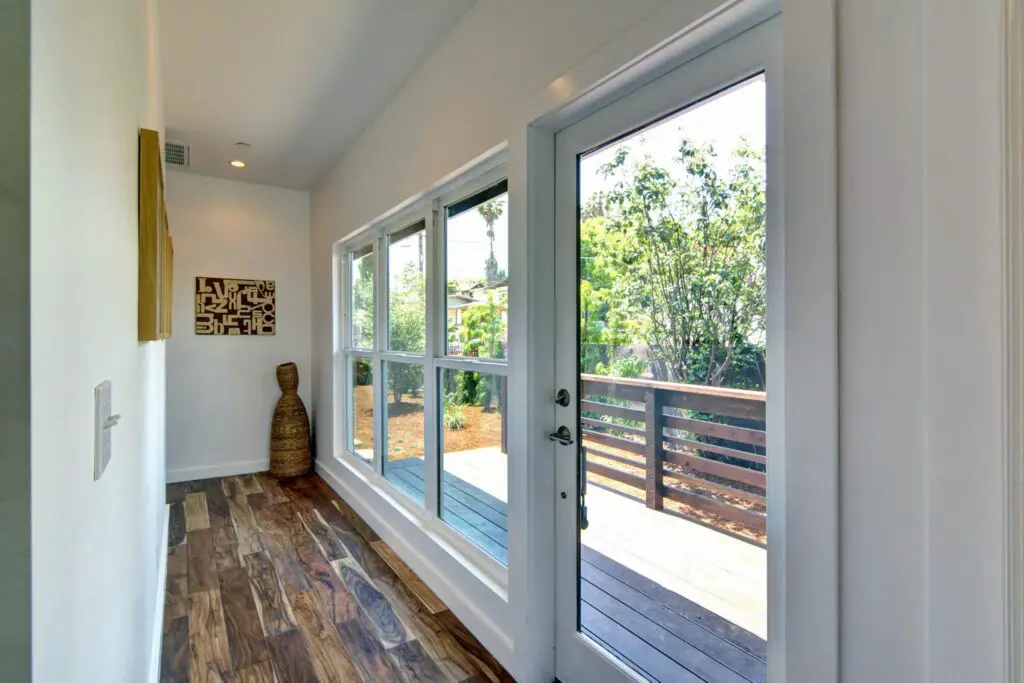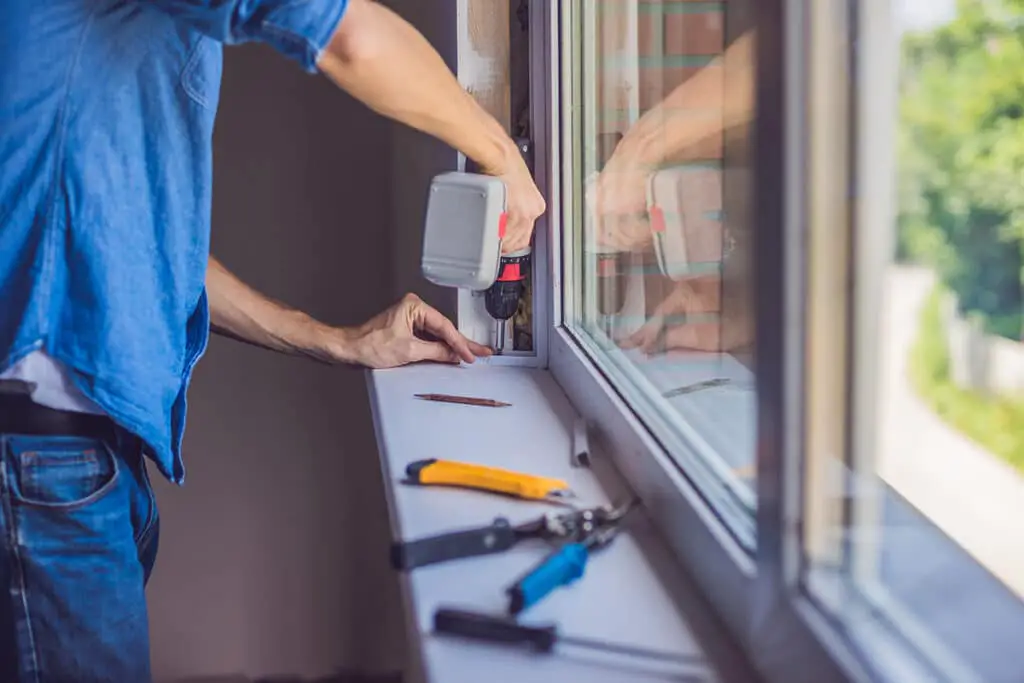How To Seal A Patio Door For Winter
Introduction
How To Seal A Patio Door For Winter: Winter can be a harsh season, with freezing temperatures and strong winds. If you have a patio door, it’s important to take steps to seal it properly to keep the cold air out and the warm air in. Sealing your patio door for winter not only helps to keep your home comfortable, but it can also save you money on heating bills. In this article, we will discuss some effective methods to seal a patio door for winter.
One of the first steps in sealing a patio slabs door for winter is to check for any gaps or cracks around the door frame. These gaps can allow cold air to seep into your home, making it harder to keep warm. Use a flashlight to inspect the door frame and look for any areas where light is coming through. If you find any gaps or cracks, use a weatherstripping material to seal them. Weatherstripping can be found at most hardware stores and is easy to install. Simply measure the length of the gap or crack, cut the weatherstripping to size, and press it into place.
In addition to sealing the door frame and using draft stoppers, it’s also important to check the condition of the door itself. If the door is old or damaged, it may not provide a proper seal. Consider replacing the door with a more energy-efficient model that is designed to withstand harsh weather conditions. A new door can not only improve the insulation of your home but also enhance its overall appearance.

How do you seal a drafty patio door?
A drafty door lets cold air in in winter and hot air in summer, making it hard to maintain a stable home temperature. Luckily, there are various ways to seal a drafty patio door and save energy.
Weatherstripping is a simple solution to seal a drafty patio door. Weatherstripping seals door edges when closed. It comes in adhesive strips or V-strips and can be constructed of rubber, foam, or vinyl. Weatherstripping is applied by measuring the door frame length and cutting the material. Remove the backing and press the weatherstripping onto the door frame, aligning it with the door edge. To seal the door, repeat this on all sides.
Sealing a drafty patio door with draft stoppers or door sweeps works too. Draft stoppers are long, narrow tubes filled with foam or sand that are positioned along the door bottom to block drafts. However, door sweeps are rubber or vinyl strips applied to the bottom of the door to seal against the threshold. Draft stoppers and door sweeps can be slipped onto the door bottom or screwed in.
How do you seal a sliding glass door?
Sealing a sliding glass door is an important step in maintaining the energy efficiency and security of your home. A properly sealed door can prevent drafts, reduce noise, and keep out unwanted pests. There are several methods you can use to seal a sliding glass door, depending on your specific needs and preferences.
Weatherstripping coats the door edges to seal it when closed. It comes in numerous forms and sizes and can be made of rubber, foam, or vinyl. Applying weatherstripping requires measuring the door length and cutting it to fit. Remove the backing and push the weatherstripping to the door edges.
Door sweeps can seal sliding glass doors. A door sweep prevents drafts and keeps out insects and debris by attaching to the bottom of the door. Rubber or vinyl, it screws onto the door bottom effortlessly. Door sweeps decrease breezes and noise by separating the door from the floor.
Sealing a sliding glass door is a simple and inexpensive solution to boost energy efficiency and security. Weatherstripping, door sweeps, and caulk can seal tightly to block drafts, noise, bugs, and weather.
How do I keep my sliding patio door from freezing?
During the winter months, it is common for sliding patio doors to freeze shut due to the cold temperatures and moisture. This can be frustrating and inconvenient, especially if you need to use the door frequently. However, there are several steps you can take to prevent your sliding patio door from freezing.
1. Keep the door and track clean: One of the main reasons why sliding patio doors freeze shut is because dirt, debris, and moisture can accumulate in the track. This can cause the door to stick and freeze in place. To prevent this, regularly clean the door and track using a mild detergent and warm water. Be sure to remove any dirt or debris that may be present.
2. Apply a silicone lubricant: Another effective way to prevent your sliding patio door from freezing is to apply a silicone lubricant to the track. This will help to reduce friction and make it easier for the door to slide open and closed. Be sure to choose a silicone lubricant specifically designed for use on sliding doors.
3. Use weatherstripping: Weatherstripping is a great way to seal gaps and prevent cold air from entering your home. It can also help to prevent your sliding patio door from freezing. Apply weatherstripping to the edges of the door and the frame to create a tight seal. This will help to keep out moisture and prevent the door from freezing shut.
4. Install a door sweep: A door sweep is a strip of material that is attached to the bottom of the door. It helps to seal the gap between the door and the floor, preventing cold air from entering and warm air from escaping. By installing a door sweep, you can help to prevent your sliding patio door from freezing.
What is the best solution for drafty doors?
Drafty doors can be a major source of discomfort and energy loss in a home. They allow cold air to seep in during the winter months and hot air to enter during the summer months. This not only makes the room uncomfortable but also increases energy bills as the heating or cooling system has to work harder to maintain a comfortable temperature. Fortunately, there are several solutions available to address this issue and make your home more energy-efficient.
Weatherstripping
One of the most effective and affordable solutions for drafty doors is weatherstripping. Weatherstripping involves sealing the gaps around the door to prevent air leakage. There are various types of weatherstripping materials available, such as adhesive-backed foam tape, V-strip, and door sweeps. These materials can be easily installed and provide a tight seal to keep out drafts.
Door Draft Stoppers
If you have a large gap at the bottom of your door, a door draft stopper can be a simple and effective solution. These draft stoppers are long, cylindrical pillows that can be placed along the bottom of the door to block drafts. They are usually made of fabric and filled with materials like foam or sand. Door draft stoppers are not only functional but can also add a decorative touch to your home.
Insulated Curtains or Blinds
Another solution for drafty doors is to use insulated curtains or blinds. These window coverings are designed to provide an extra layer of insulation and prevent drafts from entering the room. Insulated curtains are made of thick, heavy fabric that helps to block out cold air. They can be easily installed and are available in a variety of colors and styles to suit your home decor.
How do you make a sliding glass door airtight?
When it comes to sliding glass doors, ensuring that they are airtight is essential for maintaining a comfortable and energy-efficient home. An airtight sliding glass door helps to prevent drafts, reduce noise, and improve insulation. There are several steps you can take to make a sliding glass door airtight, ranging from simple adjustments to more involved repairs.
One of the first things you can do to improve the airtightness of your sliding glass door is to check the weatherstripping. Over time, the weatherstripping can become worn or damaged, allowing air to leak in or out. Inspect the weatherstripping around the edges of the door and replace any sections that are cracked, torn, or no longer providing a tight seal. This can be done by removing the old weatherstripping and applying new adhesive-backed weatherstripping in its place.
Another important step is to check the alignment of the door. If the door is not properly aligned, it may not close tightly, leaving gaps for air to pass through. To check the alignment, open the door and examine the tracks and rollers. If you notice any debris or obstructions, clean them out. You may also need to adjust the rollers to ensure that the door is sitting evenly in the tracks. This can usually be done by turning the adjustment screws located at the bottom or sides of the door.
In addition to weatherstripping and alignment, you can also consider adding secondary glazing to your sliding glass door. Secondary glazing involves installing an additional layer of glass or acrylic over the existing glass. This creates an extra barrier against drafts and noise, improving the overall airtightness of the door. There are various DIY kits available for secondary glazing, or you can hire a professional to install it for you.
Sealing a patio door for winter is an important step
Step 1: Start by thoroughly cleaning the door and its surrounding area. Remove any dirt, dust, or debris that may interfere with the sealing process.
Step 2: Inspect the door for any cracks, gaps, or damaged weatherstripping. These areas are prone to air leaks and should be addressed before sealing. Use a caulk gun to fill in any cracks or gaps, and replace any worn-out weatherstripping.
Step 3: Apply weatherstripping tape or adhesive foam tape to the edges of the door frame. This will create a tight seal when the door is closed, preventing drafts and heat loss.
Step 4: Install a door sweep at the bottom of the door to further prevent drafts. This can be easily attached using screws or adhesive.
Step 5: Consider using window film or insulating curtains to provide an extra layer of insulation. These can help to reduce heat loss and improve energy efficiency.
By following these steps, you can effectively seal your patio door for winter and create a more comfortable and energy-efficient living space.
Are there any specific materials or products recommended for sealing a patio door for winter?
When it comes to sealing a patio door for winter, there are several specific materials and products that are highly recommended for the best results. One of the most important materials is weatherstripping, which helps to create a tight seal around the door to prevent drafts and heat loss. Weatherstripping can be made of various materials such as rubber, foam, or vinyl, and it is typically applied along the edges of the door frame and the bottom of the door.
Another recommended product for sealing a patio door for winter is caulk. Caulk is used to fill in any gaps or cracks around the door frame, ensuring that no cold air can seep in. It is important to choose a high-quality caulk that is specifically designed for outdoor use and can withstand extreme temperatures. Additionally, using a caulk gun can make the application process easier and more precise.
How long does it typically take to seal a patio door for winter?
Sealing a patio door for winter is an important step in keeping your home warm and energy-efficient during the colder months. The time it takes to properly seal a patio door can vary depending on a few factors, such as the size of the door, the condition of the existing seal, and your level of experience with this type of task.
On average, it can take anywhere from 1 to 2 hours to seal a patio door for winter. This includes the time it takes to gather the necessary materials, clean the door and surrounding area, apply the sealant, and allow it to dry. However, it’s important to note that this is just an estimate and the actual time may be shorter or longer depending on the specific circumstances.
Are there any potential challenges or common mistakes to avoid when sealing a patio door for winter?
When sealing a patio door for winter, there are a few potential challenges and common mistakes that you should be aware of in order to ensure a proper seal. One common mistake is not properly cleaning and preparing the door and surrounding area before applying the sealant. It is important to thoroughly clean the door and remove any dirt, debris, or old sealant to ensure a smooth and effective seal. Additionally, make sure to properly measure and cut the sealant to fit the door, as using too much or too little can result in an ineffective seal.
Another challenge to consider is the type of sealant you choose. It is important to select a high-quality sealant that is specifically designed for outdoor use and can withstand the harsh winter weather conditions. Using a low-quality or inappropriate sealant can lead to cracking, peeling, or ineffective sealing. Additionally, be cautious of using too much sealant, as it can create a messy appearance and may not adhere properly.
Are there any additional tips or tricks for maximizing the effectiveness of sealing a patio door for winter?
Yes, there are several additional tips and tricks that can help maximize the effectiveness of sealing a patio door for winter. One important tip is to ensure that the door is properly cleaned and free of any dirt or debris before applying any sealant. This will help create a smooth surface for the sealant to adhere to and ensure a tight seal. Additionally, it is recommended to use a high-quality weatherstripping material around the edges of the door to further prevent drafts and heat loss.
Another trick is to use a clear plastic film or shrink wrap on the inside of the door. This can provide an extra layer of insulation and help reduce heat loss. It is important to properly install the plastic film, making sure it is tightly sealed and free of any wrinkles or gaps. Additionally, using draft stoppers or door sweeps at the bottom of the door can help prevent cold air from entering and warm air from escaping.

Conclusion
Sealing a patio door for winter is an essential step in maintaining a comfortable and energy-efficient home. With the cold weather approaching, it is important to ensure that your patio door is properly sealed to prevent drafts and heat loss. By taking the time to seal your patio door, you can not only keep your home warm and cozy during the winter months but also save on energy costs.
There are several methods you can use to seal a patio door for winter. One of the most common and effective ways is to use weatherstripping. Weatherstripping is a material that is applied to the edges of the door to create a tight seal when closed. It helps to prevent drafts and keep the cold air out. Weatherstripping comes in various forms, such as adhesive strips or door sweeps, and can be easily installed by following the manufacturer’s instructions.
Another method to seal a patio door for winter is by using draft stoppers or door snakes. These are long, cylindrical cushions that are placed along the bottom of the door to block drafts from entering. Draft stoppers are typically made of fabric and can be easily made at home or purchased from a store. They are a cost-effective solution to keep the cold air out and the warm air in.
In addition to weatherstripping and draft stoppers, you can also consider using window film or plastic shrink wrap to seal your patio door. Window film is a transparent sheet that is applied to the glass surface of the door. It helps to insulate the door and reduce heat loss. Plastic shrink wrap, on the other hand, is a thin plastic film that is applied to the entire door frame. It creates an airtight seal and provides an extra layer of insulation.








